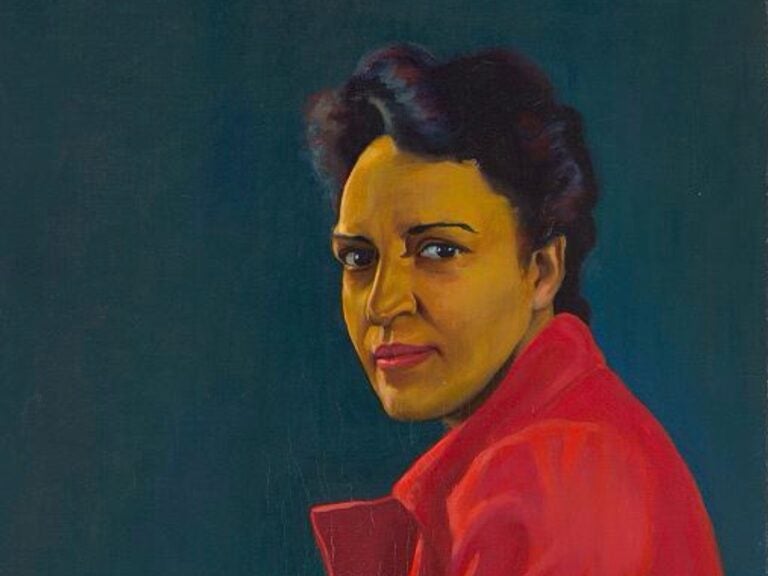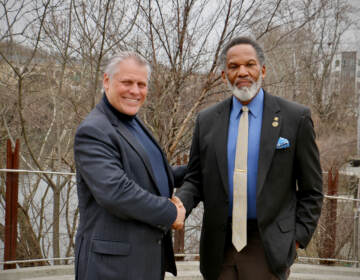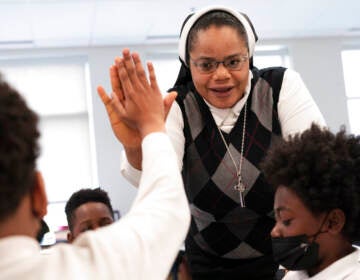Historic portraits of ‘outstanding’ Black Americans featured in new online exhibit
Pieces from a 1940s collection of portraits showcasing prominent Black Americans are back on virtual display in a new exhibition by the Pearl S. Buck House.
Listen 2:08
A portrait of Jane Matilda Bolin by Betsy Graves Reyneau. Jane Matilda Bolin was the first Black woman to graduate from Yale Law School, and the first Black Woman to join the New York City Law Department. (National Portrait Gallery, Smithsonian Institution; gift of the Harmon Foundation)
Pieces from a historic collection of painted portraits showcasing prominent Black Americans are back on virtual display, more than 75 years after the collection first debuted.
“Portraits of Outstanding Americans of Negro Origin” was commissioned in 1943 by William Harmon, a wealthy real estate developer who created a foundation in his own name to raise awareness of the accomplishments of African Americans. The series includes scientists, business leaders, activists, artists and intellectuals — like inventor George Washington Carver, opera singer Marian Anderson, philosopher Alain Locke, and Jane Matilda Bolin, the first Black woman to graduate from Yale Law School and the first to join the New York City Law Department — people Harmon thought the public should know better.
Seven paintings from that historic exhibition have been included in a new online exhibition by the Pearl S. Buck House in Bucks County, to unpack the Nobel Prize-winning novelist’s involvement with the civil rights movement, and her connections with many of its leaders who are featured in the portrait collection.
The first set of 23 portraits were painted by Laura Wheeler Waring, a Black artist who trained at the Pennsylvania Academy of the Fine Arts in Philadelphia and taught at Cheyney University for three decades; and Betsy Graves Reyneau, a white artist who trained in Boston and eventually settled in Moorestown, New Jersey.
When the exhibit opened at the Smithsonian Institute in 1944, both First Lady Eleanor Roosevelt and Vice President Henry Wallace attended. Once it had drawn more than 21,000 visitors, the Harmon Foundation set the collection out on the road for a tour, where it was shown in 40 venues over 10 years, breaking attendance records.
As the tour continued throughout the 1940s, more portraits were commissioned until there were almost 50 in total.
Then, in 1954, the United States Supreme Court ruled on Brown v. Board of Education, abolishing legal segregation. The Harmon Foundation, believing racial tolerance had been achieved, discontinued the exhibition. With racial parity achieved, the show was no longer needed.
The foundation donated 41 portraits to the National Portrait Gallery, where they are sometimes displayed, but rarely together as they were originally intended.
While the exhibition was on tour, it was often used as a backdrop for racially integrated social functions.
One organization that leveraged the exhibition to promote the advancement of civil rights was the East and West Association, founded by Bucks County novelist Pearl S. Buck.
“She created this association so that people on one side of the world could understand the other side of the world. They had radio broadcasts, they had exhibits, they had lists of books to learn about a specific country or a people,” said Marie Toner, curator of the Pearl S. Buck House, the 68-acre Perkasie estate where the Nobel-prize winning author lived.
“This exhibition became very important to the East and West Association.”
Toner created an online exhibition, “Pearl S. Buck Taking Action: Civil Rights in America,” featuring images and text pulled from the Buck archive, including seven from the portrait series.
Best known for her novels, including “The Good Earth,” and her work with international adoption and children living in poverty, Buck also devoted much of her time to promoting civil rights and racial equality in America.
“I don’t think people know her work with civil rights,” said Toner. “Now more than ever, we need to know she did these things.”
The exhibition traces Buck’s personal connection with many of the portrait subjects. She was a frequent contributor to “Opportunity: Journal of Negro Life,” co-created by Eugene Knickle Jones. Buck delivered a graduation commencement address at Howard University during the tenure of its first president, Mordecai Wyatt Johnson. She corresponded with Channing Tobias, a member of President Truman’s Committee on Civil Rights and first Black director of the Phelps-Stokes Fund.
In 1949, she co-wrote a book with Eslanda Goode Robeson, wife of the singer Paul Robeson, about their conversations on race, called “American Argument.” Buck also adopted two Black children.
Buck was also an acquaintance of Reyneau, who gave Buck copies of the portraits she painted for the series. The images in the online exhibition come from the Buck archive of monochrome copies of the original full-color canvasses.
Toner wants to place Buck in the civil rights movement to show a lesser-known side of the literary giant as a strong advocate for racial justice — Langston Hughes once described Buck as the “current Harriet Beecher Stowe to the Race,” referring to the 19th century abolitionist and author of “Uncle Tom’s Cabin,” because of her work against racism.
Although Buck was hardly at the center of the civil rights movement, she was part of a diverse network promoting racial equality that included many people featured in the Harmon portrait collection.
“Including the portraits really showed the power of people working together to come up with a solution,” she said. “It really highlighted what Pearl Buck did.”

Get daily updates from WHYY News!
WHYY is your source for fact-based, in-depth journalism and information. As a nonprofit organization, we rely on financial support from readers like you. Please give today.






